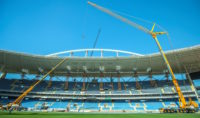Now that athletes Simone Biles, Michael Phelps and other Olympians are setting historic gold-medal records since the Rio de Janeiro summer festivities opened on Aug. 5, complaints of construction problems at the event have dropped off significantly among the public.
However, the construction industry continues to study the multiyear buildup of the Rio Olympics as a costly engineering project that came with risk-management challenges, and it provides lessons for future cities hosting large megaprojects such as the Olympic Games.
According to a study at the University of Oxford business school, the buildup of the global event in Rio surpassed original budget estimates by $1.6 billion, or 51%, totaling $4.6 billion in sports-related costs. This bill comes at a time when Brazil is suffering from a crippling recession and political scandal—the latter of which has spilled into international lawsuits against Petrobras, the country’s quasi-governmental energy corporation.
Since the Olympic Village opened in Rio for the summer competition, international delegations complained the facilities lacked basic amenities that operated properly—the major criticisms of plumbing, electrical, gas and fire-protection systems forced workers to scramble earlier this month to make sure the opening of the Summer Games was a success.
Reports of the first athletes arriving at the scene showed the absence of fire hoses on some floors, water leaks and electrical networks exposed. The delegations of Australia and Argentina were some who first complained of problems.
Now that the games are well underway, complaints of such construction problems are much fewer.
Built by Odebrecht Achievements and Carvalho Hosken, the Olympic Village includes 31 buildings of 17 floors each. In total, 3,064 apartments are housing about 15,000 athletes of the Olympic Games and the Paralympic Games.
According to the International Olympic Committee (IOC), when finished with the games, the area will be occupied by owners who bought residences on the property. Apartments in the Olympic Village are selling from roughly $320,000 up and are focused on upper- and middle-class buyers.
The project also involves the future construction of commercial buildings within the districts of Olympic Village and Rio Olympic Park.
On July 24, the first day after receiving criticisms of failures, the consortium building the Olympic Village set up a task force with 600 workers, including plumbers, general-services assistants and electricians, working for 24 hours to remedy the problems pointed out by the athletic delegations.
Another early problem faced by the Rio Summer Games occurred in the Marina da Gloria, which hosts the sailing competitions. The main access ramp to the Guanabara Bay was partially destroyed after a sea turmoil and strong winds, six days before the games began.
Today, the structure is now fixed.
Augusto Diniz is the editor of O Empreiteiro magazine, a construction publication in Brazil.





Post a comment to this article
Report Abusive Comment